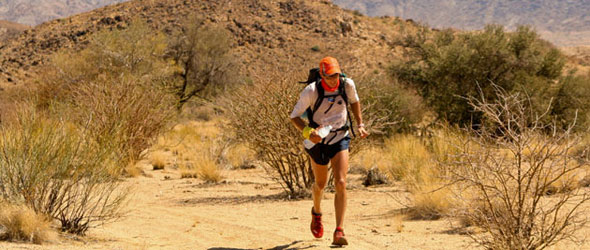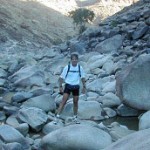After having held the above event in the Namib Desert around Swakopmund (in Namibia) for the past two years, the organisers decided to move the race to the Augrabies National Park area on the Orange River (in South Africa) this year. This turned out to be a good decision as most of the top South African teams were represented at the race this year. The Namibian pair of Russell Paschke and Coenraad Pool were at this race for the 3rd consecutive year. After their 2nd place finish in last year’s event (on home soil), they were out to prove that this was not a one off result.
From the outset it was apparent that this was going to be a closely fought race amongst the front runners. With temperatures in excess of 42 degrees it was clear that those teams that paced themselves properly and avoided dehydration, would be the ones fighting for top positions at the end of the race.
The race briefing and registration took place at the Khamkirri camp on the banks of the Orange River on Friday 20 September 2002 at 20:00. After the usual introduction of teams and explanation of the rules for the event, the teams were all handed the race instructions and maps required for the event. The next two hours were taken up by the teams plotting the various passport control (PC) points, as well as the transition (T) points, and then deciding on the best route alternatives to reach these points. By midnight, most teams had finished their route preparations and packed their kit for the first leg. This meant that they would be able to have the “luxury” of a 5 hour sleep before getting up for the start of the 1st leg. For the front teams, this would be the last meaningful sleep for the next 40 hours.
The race started on Saturday morning at 6:30 with a 25km paddle on the Orange River, which included a 3km portage section where the boats had to be carried around a weir which could not be paddled on the river. With the Orange River level very high and flowing fast, this 1st leg passed fairly quickly with most of the top teams together at the front. Russell Paschke unfortunately capsized in one of the early rapids and this meant that he and Coenraad were about 20 minutes back on the leading group coming into the 1st transition. Tommy van Wyk, a doctor doing his internship in Windhoek at the moment, was together with them at this stage but opted to slow down and take the race easier as it was his first event. This turned out to be a wise choice as he was one of only 7 participants of the 21 that started the race to finish.
The next leg of the race was a 60km mountain bike section that saw the competitors having to pass through PC1 and PC2 before reaching the next transition T2. The temperature was well into the 40’s at this stage and it was already obvious what affect it was going to play during the course of the race. Sonja and Hano Otto of team Mazda Drifter made a wrong turn and ended up lost for 3 hrs in the heat. This effectively left them out of the race and Hano decided to continue on his own simply to complete the course. This left teams Kinetic (Johannesburg) and Energy (Cape Town) out in front with Richard Starr and Nicolas Mulder (two solo entries) about a half an hour back on them. Russell and Coenraad followed in 5th place at this stage about an hour behind. They had unfortunately relied on some local advice in getting to PC1 and soon realised it was not that reliable and that they had in fact gone past the point. After turning back about 4km they found the PC point. After a disappointing start to the race, they decided that from there on they would rely only on the map and compass and their own navigational skills. This was a decision that would pay dividends as the race progressed.
Coming into T2, Russell & Coenraad were now 1,5hrs back on the two leading teams of Kinetic and Energy. The two solo entries of Richard and Nicolas were also still about 30min ahead. Russell and Coenraad both resisted the urge to push the pace any harder to try to catch up to the front teams as they were both aware from past experience how such an early pace up front could catch up to you later in the race. After a 45 min rest and packing of kit at T2, it was off onto the next two legs, a 15km paddle on the Orange River followed by a 48km hike. This really turned out to be a decisive leg that took almost 12 hours to complete and started to shape the race. Teams Kinetic and Energy were still pushing the pace hard up front, but Richard Starr had started to faulter and eventually ended up withdrawing from the race on this leg. Nicolas Mulder made a navigational error and missed PC 4 allowing Russell and Coenraad to move into 3rd position. By the time they reached T4 at 01:00 on Sunday morning, Russell and Coenraad were 3hrs back on the leading two teams. After having been non stop on the go for 18,5 hours, they decided to sleep half and hour before setting out on the next leg.
At exactly 02:00, Russell and Coenraad set off on the next leg a 65km mountain bike leg. This turned out to be a really tough leg with numerous sections of thick river sand which meant that the bicycles had to be pushed a lot. On reaching PC5, they were pleasantly surprised to find Team Energy sleeping. The early pace had taken its toll on them and they were suffering the effects of dehydration and exhaustion. After clipping their passport, Russell and Coenraad set off on the last section of this mountain bike leg with the knowledge that the only team in front of them was that of Kinetic.
On reaching T5, Russell and Coenraad were amazed to find out that they had closed the 3hr lead down to 2hrs. The remaining leg of the race, a monster 56km hike in the heat of the day and through hostile terrain, would be the one that decided the winner of the Desert Challenge for 2002. Before the hike started however, all teams had to complete a rope skills discipline that entailed a 95m abseil followed by a 80m climb to the top of the canyon again. On completing this section, Russell and Coenraad set off in pursuit of team Kinetic, 2hrs ahead of them. At this stage, Coenraad suggested taking a route that was approximately 6km further than the obvious direct route to the next PC point. The reasoning behind this was that it was along a jeep track as opposed to the direct route up the river bed. This would mean that although it was longer, it could probably be covered in a shorter time if they could run some of this distance on the road. After agreeing on this choice, they set off running the downhills and flats and walking the uphills. By midday it was way to hot to continue with this strategy and they decided to settle into a fast walking pace. After what seemed like a lifetime, they eventually reached PC7 after 5,5hrs. On reaching this point they were informed that they were now only 55min behind the leading team. This meant that in the last 26km they had halved the lead and were closing.
The final hike of about 30km was turning out to be an exciting prospect for the organisers and supporters. It became a case of two teams giving all they had and it was simply boiling down to whether team Kinetic could hold out, or would Russell and Coenraad be able to close down the lead. At this stage both teams were physically worn out and it was simply the minds that had taken over. With 6km left to go to the end and the sun setting, Russell and Coenraad crossed over the game fence and onto the gravel road leading back to the finish at Khamkirri. At this stage they knew that they were close to the leaders, but had now idea of exactly how close. Suddenly they noticed the TV camera crew ahead and were informed that team Kinetic was about 2km ahead of them. On hearing this, the adrenaline simply kicked in and they broke into a steady jog for the next 5km trying to close down the lead. Unfortunately for them, the same TV crew had also made Kinetic aware that they were being chased down and this prompted them to start running as well. At the end of the day they had just enough left in them to stay out front and eventually finished the race a mere 7 minutes ahead of a fast finishing Russell and Coenraad. At exactly 19:42 (37hrs 12min) Russell and Coenraad crossed the finishing line to a standing ovation from all the organisers and support crew. They had ensured a nail biting finish and it is unreal to think that after 37 hours of racing over a distance of 240km, only 7 minutes would separate the top two teams.
The difficulty of this event became obvious when the results were analysed and it was made known that only 6 of the 21 competitors who started the race managed to finish the whole course. A further 4 managed to complete a shortened course after they failed to make the cut off at T4. These results once again highlighted the brutality of this race and made one realise that finishing this race was in itself an achievement that all the competitors could be proud of.






















[…] Desert Adventure Challenge – 2002 is a post from: Time-to-Run Namibia […]